Nestos
Nestos is a national park in East Macedonia in northern Greece.
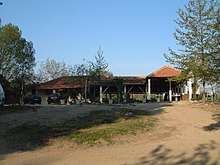

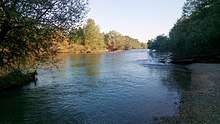
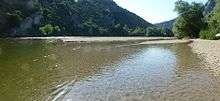
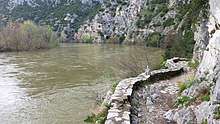
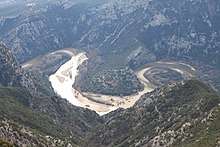

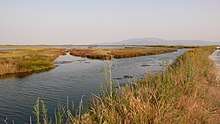
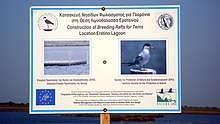

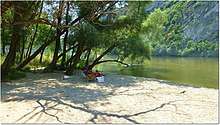
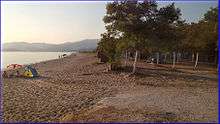

Understand
About 30 km east of Kavala lies the nature reserve of the Nestos river. The river basin of the Nestos is divided into the Nestos gorge at Toxotes and the Nestos delta at Chrysoupolis. Both are areas with a high bird population and unique natural beauty. Along the river Nestos there are a number of special ecosystems. The river delta of Nestos is a hydrobiotop with alluvial land, freshwater lakes and lagoons. In particular, due to its rich birdlife, the National Park was created, which also includes the eastern lakes Vistonida and Ismarida. The area is a resting place for many species of birds on their winter migration. Of particular importance is the floodplain forest on the banks of Nestos. Until the middle of the 20th century, very large parts of the original area of these river forests were cut down to gain agricultural land. Nestos Delta together with the Lake Vistonida and Lake Ismarida are part of the East Macedonia and Thrace National Park.
Landscape
The Nestos Delta is a typical flat alluvial plains with intensive agriculture such as mais, asparagus, kiwi, rice, cereals, networked with irrigation channels and ditches. Only along the Nestos river are the remains of a floodplain forest, where a rich bird life is at home. About 60 ha of it is fenced under nature conservation. The juxtaposition of forest and open meadows creates habitats for a variety of different bird species. On the western edge of the delta are extensive lagoons, spits and dunes, which are visited by many of the migratory birds as a resting place at the time of bird migration. The delta has many closely related ecosystems, which has a positive effect on fauna and flora. The area around the Nestos gorge is mountainous with the typical Mediterranean maccia growth.
Flora and fauna
Due to the multitude of ecosystems which are close to each other an unusually diverse fauna and flora can be found in the Nestos area. Three main ecosystems can be distinguished: 1) along the revine, 2) at the lagoons 3) along the river itself
In the Nestos ravine natural alluvial forests with poplars, plane trees, willows, alders, etc. grow directly on the river. On the slopes, the composition of the herbaceous vegetation changes according to their exposure to the sun (to the north = cooler, to the south = warmer).
At the lagoons, coastal dunes and inland inland dunes have very different herbaceous to bushy vegetation depending on the salinity of the soil and the water availability. Here, in addition to a variety of amphibians, reptiles (such as European toad, Moorish tortoise, arrow snake) and insect species live a rich bird life (flamingos, pelicans, etc.)
Along the river you will find the richest fauna and flora. On the river grows a lot of hardwood forest, within the flood dams softwood woodland forests (black alder, silver poplar) and on the edge of the fields often poplar forest. The under-growth is almost impenetrable, especially near the river. In the floodplain live, for example, Pale Skewers, Kingfishers, Mask Shrikes, Nightingales, Lesser Spotted Eagles, Sparrowhawks, and in the drier areas Bee-eaters, European reeds, Oriole, and others. Also many species of butterflies and dragonflies can be seen near the shore and on the islands in the river. Since the construction of the Nestos dam, the earlier winter floods have stopped and in summer the river carries more water. This has led to a major change in the river landscape. Increasingly large vegetation islands arise in the shallow riverbed, so that one usually no longer sees the other side of the river. On the edge of the floodplain forest in the meadows and also in the villages storks are frequently to be found. Almost every village has nesting sites.
Get in
Most visitors to the region come via 🌍 Kavala Airport (KVA IATA), which is only 12 km from the village 🌍 Chrysoupolis, the center for exploring the Nestos delta. From Kavala there are regular buses to Chrysoupolis or direction Xanthi with stop at 🌍 Toxotes, the village at Nestos Gorge. Visitors who want to explore the Nestos area from Thasos can either take the ferry to 🌍 Keramoti (near the mouth of Nestos into the sea) or via Kavala. From Keramoti regular buses run to Chrysoupolis, from where buses can be taken towards Xanthi to Nestos Gorge. You can reach the river from either the Macedonian west side or the Thracian east side. The Thracian side, with a predominantly Muslim population, is less touristy and therefore most visitors choose the west side of the river for their excursions. A bridge over the Nestos does not exist in the delta, so you have to drive to Toxotes if you want to get to the other side of the river.
The easiest way to reach the Nestos area is by car. Coming from Thessaloniki take the exit Chrysoupolis for the west side or at Evalo/Toxotes for the east side or the gorge.
Get around
You can reach all the interesting places by bus from Chrysoupolis, Keramoti or Toxotes, but with long foot walks from the bus stations. The most comfortable way to explore the area is by rental car, which can be rented directly at the airport. If you come by ferry boat from Thasos, you can also hire a car in Kavala (there are several suppliers between the port and the aqueduct) or even easier rent a car in Thasos and take the car ferry to Keramoti. Since the area is flat, you can also explore it by bike.
See
- Nestos Nature Museum, 117 Venizelou St., Chrissoupoli, ☎ +30 2591 24289.
- 🌍 Nestos Delta. The Nestos delta is one of the most important breeding grounds for rare bird species and an intermediate station for migratory birds. As a wintering area for a variety of water, singing and birds of prey, it is popular with ornithologists. In the delta of Nestos over 250 species of birds have been described, including rare and endangered species. Also for non-ornithologists the alluvial forests of the delta is worth a visit. The best starting point is the Nestos-Cafe at Chysoupolis (in the center of Chrysoupolis follow the signs). The simple restaurant is located on the riverbank in the middle of the floodplain forest overlooking the river. Here you can enjoy the nature with "a glass of ouzo" on the terrace or make hikes along the dam or in the river itself. The Nestos is flat in the delta area and can be easily waded in most areas. Especially in the summer, it is a pleasure to wade or swim in the cool water. The water quality is good. To get into the interesting estuary, you do not necessarily need a 4WD, but makes it easier. Since there are no signs, it is advisable to look at the course of the route on Openstreetmap beforehand.
- 🌍 Nestos Gorge. Nature is of particular beauty at Toxotes (40 km east of Kavala). It is one of the must-see attractions. In meanders, the river breaks through the limestone mountains and forms a landscape of unique beauty. At the gorge, a path of more than 10 km leads along towering cliffs and with a wonderful view of the river. To get to the starting point of the path, drive through Toxotes and follow the signs to the end of the road to a parking lot. Here are boards with exact directions. Most visitors walk the path for only 1-2 km and then return to the car park. There is also a snack bar with souvlaki and cold drinks. In the summer, take a dip in the ice-cold waters of Nestos. The water is so cold, that even in the hot days of July some overcoming needs to be submerged. A large sandy beach invites you to linger. The water quality is good, the flow but quite strong. There are also canoe tours through the gorge, which are highly recommended. From Galani, a small settlement between Toxots and the car park, a winding road leads to a hilltop with wonderful views of the Nestos Gorge. The road is signposted as a "scenic road". The trip is highly recommended.
- 🌍 Nestos Lagoons. On the western edge of the delta are extensive lagoons, spits and dunes from the village of Eratino to Keramoti, which provide food for a rich birdlife. Also popular are the beaches along the lagoons for summer bathing. They are mainly frequented by locals and are never crowded and without beach bars. The water is shallow and well suited for families with children and for people who love the peace more on the beach than the hustle and bustle. There is no rental of beach chairs and umbrellas as it is a nature reserve.
Archaeological sites
- 🌍 Abdera archaeological site. 08:30-15.00. was a significant ancient Thracian port city and home to the philosophers Democritus and Protagoras. Today, there are some interesting ruins and an archaeological museum in the modern village of Avdira and it is really worth going once you are at the east side of Nestos river. In addition, the nearby beaches are among the best in the region.
- 🌍 Topiros. The current municipality of Topeiros owes its name to a town that existed on the Via Egnatia during the Roman era, in the same area in which the municipality is today. Few remains of the ancient city of Topeiros with Byzantine-era ruins are tucked away and overgrown by vegetation lie between the main road and the Nestos River. Topiros was founded in the 1st century AD as a station on the Roman Via Egnatias. The city had its own coins, which testifies to the wealth and importance. With the division of the Roman Empire into East and West Topeiros belonged to the East and forms its western border. In 549 AD, the city was conquered by the Slavs, who completely destroyed it. 2 years later, Justinian I rebuilt it and surrounded it with stronger walls. It was finally destroyed in 812 by the Bulgarian tsar "Croumo".
- 🌍 Pistyros archaeological site. Pistyros was an ancient Greek polis that was founded as a colony of Thasos about 500-600 BC. In order to get to the ores in hinterland and sell their own goods on the passing there trade route. The excavation work is still in its infancy and only a few remains of the wall are visible. Since the signposted archaeological site is located directly on the main road at Pondolivado, a short stop is worthwhile.
- 🌍 Castle ruins Petropigi. A fortified station on the Via Egnatia dates back to the late Byzantine period (13th-14th centuries) with some changes from the early Turkish period, when it was used as a 'caravanseray' until about 16th century. Preserved are some fortress walls. The interior of the castle ruin is completely overgrown with shrubs.
- 🌍 Akondisma archaeological site. Founded in the 6th century BC. on the top of the hill above today's very popular hotel village as a colony of Thasos and Paros because of their interest in precious metals from the hinterland and as a distribution center for goods from the islands, such as honey, olives, fish, wine, cheese, pottery, wood products. Later it became a military base for the Macedonian kings and Romans. Due to the location on the Via Egnatia Akondisma gained in importance as a commercial center. With the decline of land-based trade in favor of maritime trade, Akondisma also lost its importance and henceforth existed as an agricultural settlement. Under Ottoman times (from 1350 AD) and the establishment of a rest area for traders to and from Istanbul, the place recovered again until it was completely destroyed by bombing in the First World War. Today a very interesting hotel complex in the stalk of an old village is located below the ruined city. Since it is located directly on the main road, it's easy to make a stop and worth a short sightseeing tour.
- 🌍 Fortress Halkero. On a hill near Halkero are the ruins of a very large fortress. It is a real "lost place" because, despite its size, it is not described in the literature and virtually nothing is known about the builders. The somewhat arduous climb is also worthwhile because of the beautiful view.
Do
- Bird watching. Starting point for observations on the river is usually the area around the Nestos Cafein the early morning or alternatively upstream to the mouth. Good clothing and footwear are required, as the shore is usually hardly accessible and wild, so you have to scrub through to get to good observation points. At the lagoons at Eratino, Agiasma, Keramoti you always have a clear view. The observation is best during the time of bird migration.
- Hiking. The most beautiful hiking trail leads along the Nestos gorge, starting at the parking lot to the gorge and leads to Stavropolis. But most people walk only 1-2 km along the path and then go back, which is quite enough to see the landscape. At the Delta you can start a walk along the dam at Nestos Cafe. From the dam paths turn off towards the river. Here is the area of bird lovers and connoisseurs of rare plants, insects and reptiles.
- Rafting.
- Horse riding.
- Canoeing.
- Bath. Good beaches for swimming at 🌍 Eratino, 🌍 Agiasma, Keramoti and especially at 🌍 Mangana. On the banks of the river Nestos you can swim near the parking lot at the beginning of the gorge and in the delta for example at the Nestos Cafe or wherever the river is accessible.
Buy
The best shopping is in Chrysoupolis. Several large supermarkets are located on the bypass, e.g. Lidl. In the city center you can find a rich selection of specialty shops. Smaller supermarkets and other daily necessities are also available in Keramoti. Nearly all smaller villages have bakeries and mini markets.
Eat
At the delta:
- 🌍 Nestos Cafe. The only cafe-restaurant on the riverbank in a wonderful location (temporarily closed). A must for every visitor to the Delta and starting point for hikes. Alternatively, there are many restaurants and fast foods in both Chrysoupoli and Keramoti
At the gorge:
- 🌍 Tempi Nestou (Τεμπη Νεστου). Good food, big portions, reasonable priced.
- 🌍 Mezedopiimata (Μεζεδοποιήματα). good restaurant in the centre of Toxotes village
- 🌍 Canteen Nestos (Αναψυκτήριο Νέστου). Canteen with simple food and draft beer under shady trees right on the parking lot to Nestos gorge
At the lagoons:
- In Agiasma there is a snack bar directly at the traffic light in the village center. Otherwise you can go in every village in a Kafeneio where you always can get small side dishes to the drinks (mese = tapas).
Drink
Every village has kafeneios (bars usually frequented by older men) and simple cafes. Chrysoupolis and Keramoti offer a wider rage of bars and nightlife, especially in the main tourist season.
Sleep
If you are mobile and do not want to stay in Chrysoupolis or Toxotes, Keramoti has a great selection of beach hotels that are much better.
- 🌍 Hotel Filoxenia. In Toxotes
- 🌍 Hotel Irini. In Chrysoupolis
- 🌍 Camping Keramoti.
- 🌍 Camping Nea Karvali.
- 🌍 Akondisma. very romantic hotel complex in the stalk of an old village near Nea Karvali
Connect
All over the area you can have mobile internet and most cafes and restaurants offer free Wifi.
Safety
- "Crime" is almost non-existent.
- In the Nestos Delta you should bring enough mosquito repellent and suitable footwear.
- In the Nestos Gorge, good footwear is required if you want to walk the path along the gorge. Here are also more snakes to be found than usual. The river is popular here for swimming. Although it is not deep, the current is quite strong and the water is very cold. Special attention must be paid to children.
Go next
- Kavala
- Thasos-Island
- Pangaion Hills
- Xanthi
- Samothrace-island
- Chalkidiki
- Thessaloniki
- Rhodope Mountains